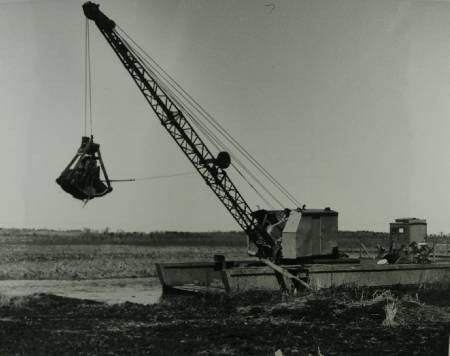In 1829, a man named William Milloy decided we needed a tavern, so he built one at the fork of the road out to the Scotch Settlement and the road to the north.
Business flourished until a new survey was proposed and a new town site was laid out incorporating Barrie, Holland, John and Colborne streets. Now Milloy’s tavern was in the middle of the Stoddart's farm. He moved south and built a new tavern called The Bullfrog.
In 1832, John Edmanson built a hotel on the northeast corner of Holland and Nelson streets. It is considered the oldest remaining building in town. It is now a private residence. This started the building boom in Bradford with grocery stores, banks and taverns being built, and people started to move into the area. A stage coach came in 1833, followed by a post office in 1835 and a steamboat in 1850. To secure the growth of Bradford, the railway system came through in 1853.
In 1857, 10 years before Confederation, Bradford became an incorporated village, with the first reeve being Thomas Driffill.
Bradford was open for progress.
For those of you wanting to know how the name Bradford came about, it was named after Bradford, England, and was a quaint little place to live in.
In 1871, Bradford history was altered when fire destroyed most of the town. There were 130 homes and places of business destroyed overnight. A new Bradford arose out of the ashes, this time using brick exteriors. In the last 25 years of the 19th century, Bradford was a relaxed atmosphere, even boasting an 1,800-volume library available for 50 cents a year.
In the early years of the 20th century, Bradford enjoyed the good life as the ladies studied music, china, oil painting, and fine embroidery. Churches flourished. Music lifted the spirits as choirs sung on Sunday mornings and the men introduced to lacrosse started to put the town on the map, even bringing home the Ontario championship in 1905.
Things soon stopped when the First World War started in 1914.
After the war, the communities of Bradford, the Township of West Gwillimbury and the Township of King signed a contract for the draining of the Holland Marsh under the direction of professor William H. Day. The year was 1925 and Dennis Nolan was reeve of Bradford. The project finished brought notoriety to Bradford as ‘the heart of Canada’s vegetable industry.’
In early 1930, under the leadership of Nolan, Bradford got a waterworks system after drilling different wells in the area.
The same year, the world slowed to a stop when the ‘dirty ’30s’ came along. Bradford was at a standstill with little or no money to spend, and things looked dreary for a time. The only thing to look forward to was the few acres of crops grown in the marsh — as it is today, ‘farmers feeding the people.’
In 1934, a few immigrants from Holland arrived and homes were built in the marsh. This was the beginning of what has become an enterprise even Day could not imagine in the greater scheme of his.
Bradford began experiencing an influx of European immigrants to the Holland Marsh with the new settlement of Ansnorveldt — Ansnorveldt meaning ‘On Snor Land.’ One of the earliest immigrant families was the family Snor.
Again, things were going well until the afternoon of Oct. 15, 1954, when Hurricane Hazel swept through.
People were in their homes on the marsh with no way to get to higher ground. In the morning, boats were out rescuing people, many who had spent the night on top of their roofs or on second floors of their homes. The DePueter family home was lifted off its posts and drifted across the marsh until it stopped on the west side of the new Highway 400. They had a few children, so when their house listed to one side, the patriarch would usher his family upgrade to straighten the house. Old eight-millimetre movies are still around showing their progress.
A tent city was set up in the Bradford arena lot and residents set to work bringing down blankets, clothes and plenty of food to look after the wet and scared families. Mrs. G.G. Green, who lived at the corner of Hurd and Church streets, got a call to help with food. When she opened her cellar door to get pickles and other items, she could not believe it was flooded to the top of the staircase and all her preserves were floating around. The water came so fast, the storm sewers backed up even to the highest part of Bradford.
Out of diversity came some good, and the Bradford Community Centre and curling rink were finished just before the 100-year celebrations in 1957.
In 1960, Bradford became a town and began a new era. D. Arthur Evans became the first mayor of Bradford and the only man with the distinction of being the village reeve (1953-59) and the town’s mayor. The only thing changed in governance was we now had a mayor and reeve as Joe Magani was elected reeve (1960-76).
The newly elected mayor helped Bradford grow, seeing Elkel Metal and Bailey River Farms locate here, a number of new apartment buildings built, and population growth giving Bradford 4,000 residents. During the 1970s, there was pressure to have Bradford join York Region, but it was decided Bradford would be better off staying with Simcoe County. In 1978, Magani did not put his name on the election ballot and there was a race for the position between Art Turner and Roy Gordon.
The new mayor of Bradford was Gordon, who was credited with modernizing and fine-tuning the town’s municipal affairs. He was also noted for hiring Bradford’s police chief, John Harrison, who turned his force into one of the most progressive and effective in Ontario.
In 1980, he stepped down and a new mayor, Zyg Fenik, took the oath of office.



